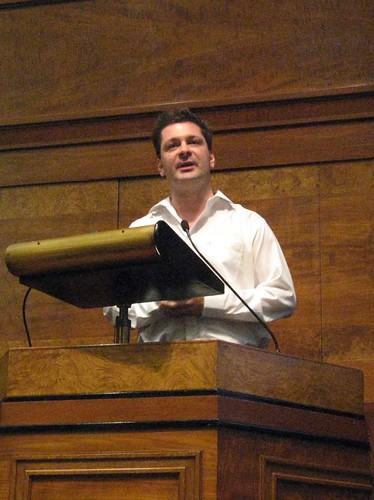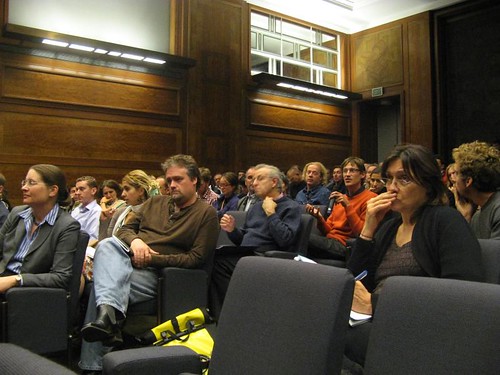A short video of the 2009 International Award winners
Friday 30 October 2009
Power for Life
Wednesday 21 October 2009
Sunday 18 October 2009
Ashden Awards and RIBA: International dialogues on architecture and climate change
Last week the Ashden Awards participated in the RIBA event series 'International Dialogues on architecture and climate change', arranging for three of our past UK winners to make presentations to the audience, followed by a time for questions and discussion.
The aim of the evening was for the speakers to present how, if they were the Government Minister responsible for zero carbon new buildings, they would ensure that targets for delivering zero-carbon homes by 2016 and zero-carbon non-domestic buildings by 2019 were met.
Jonathon Porritt chaired proceedings, and brought in an international element in his opening speech, telling the audience of a recent trip to Shanghai, where he saw significant progress being made on zero carbon buildings. Architects and engineers there are often frustrated by the image that China has in the West, as they actually understand a lot about how to achieve the goal of low or zero carbon building. However, Porritt also reminded the audience that new build only represents a small fraction of energy use in buildings, and that refurbishment of existing housing stock is essential. To further this, he would like to see more use of Display Energy Certificates, placing them in prominent positions in all non-domestic buildings to highlight to visitors the energy efficiency, and 'shame' organisations into improving it. Chris Davidson of Geothermal International (2009 Ashden Award winner) presented his case first, saying that reducing demand for electricity and de-carbonising the national grid was a priority, but that we also had to have in mind the goal of eliminating the use of fossil fuels for heating - he noted that this puts the use of gas-fired micro CHP in doubt. He said that zero-carbon technology would be required at a household level, but that it must be cost-effective and have a low embodied energy relative to the energy it generates.
Chris Davidson of Geothermal International (2009 Ashden Award winner) presented his case first, saying that reducing demand for electricity and de-carbonising the national grid was a priority, but that we also had to have in mind the goal of eliminating the use of fossil fuels for heating - he noted that this puts the use of gas-fired micro CHP in doubt. He said that zero-carbon technology would be required at a household level, but that it must be cost-effective and have a low embodied energy relative to the energy it generates.
Davidson claimed that heat pumps fulfil this role, and should be mandated in all new-build situations where their use is practical, and that we should not ignore the need for cooling in some buildings, especially as this can raise the efficiency of the heat pump by using the ground below the building as a store of heat, topped up in the summer and drawn on in the winter. If heat pump demand grows as predicted, the biggest challenge facing the installation industry is making sure it can grow fast enough. Davidson was followed by Jonathan Hines of Architype (also a 2009 Ashden Award winner). Hines took a different approach, asking the audience to consider if they would create a "zero rubbish" economy by mandating that new homes had to have built in recycling plants, with grants to make the affordable. The answer was no, of course, as reduction in the amount of waste produced combined with community-scale recycling is more effective. Hines felt that this approach should also be taken with energy and carbon, and that demand had to be reduced through intelligent design of buildings before installing micro-generation equipment, and that community-scale renewables were more cost-effective than those used at a household level. He gave an example of a few large wind turbines producing as much power as over 100,000 micro turbines, and at a lower cost and with less maintenance required.
Davidson was followed by Jonathan Hines of Architype (also a 2009 Ashden Award winner). Hines took a different approach, asking the audience to consider if they would create a "zero rubbish" economy by mandating that new homes had to have built in recycling plants, with grants to make the affordable. The answer was no, of course, as reduction in the amount of waste produced combined with community-scale recycling is more effective. Hines felt that this approach should also be taken with energy and carbon, and that demand had to be reduced through intelligent design of buildings before installing micro-generation equipment, and that community-scale renewables were more cost-effective than those used at a household level. He gave an example of a few large wind turbines producing as much power as over 100,000 micro turbines, and at a lower cost and with less maintenance required.
To achieve these goals, Hines proposed that government should mandate maximum kWh/m2/year usage for heating and for total energy for new buildings, and said this could be achieved through "passive design", making use of solar gain for heating and natural ventilation for cooling. Using wood in building was alsi said to be an advantage, as it locks up carbon for the lifetime of the building, in addition to avoiding the carbon emitted when producing concrete, bricks and metals. His aim overall is that the problems we face on energy consumption should not be tackled purely by the application of technology, but that buildings should be designed to avoid the problems in the first place. The next speaker was Jeremy Leggett of Solarcentury (2007 Ashden Award winner), who started by saying that there were no 'magic bullets', and that a combination of energy efficiency and all the available generation technologies would need to be used to reduce carbon emissions. He went on to list the advantages of solar PV in this mix, namely its durability, steadily reducing cost and confidence in the industry, which is receiving significant investment, even in these troubled financial times. He also said that an increase in the use of solar PV would have positive knock-on effects, such as increasing the number of jobs for installers and manufacturers.
The next speaker was Jeremy Leggett of Solarcentury (2007 Ashden Award winner), who started by saying that there were no 'magic bullets', and that a combination of energy efficiency and all the available generation technologies would need to be used to reduce carbon emissions. He went on to list the advantages of solar PV in this mix, namely its durability, steadily reducing cost and confidence in the industry, which is receiving significant investment, even in these troubled financial times. He also said that an increase in the use of solar PV would have positive knock-on effects, such as increasing the number of jobs for installers and manufacturers.
However, Leggett wants solar manufacturers and installers to work more closely with architects, and believes that government needs to make FITs (Feed In Tariffs) more generous in order to persuade people to spend their own money on the technology. He felt that there is also a deeper problem in government and the civil service though - a reluctance to support micro-generation as it represents a loss of the control given through centralised systems. Following the presentations was a time for questions, some of which led to interesting debates between the panel members as well as the audience.
Following the presentations was a time for questions, some of which led to interesting debates between the panel members as well as the audience.
 Several points came out of the question time:
Several points came out of the question time:
Jonathon Porritt drew the lively discussion time to a close, saying that there was no case of 'either/or', but that we needed to use all the technologies available to reduce our carbon emissions in order to meet our goal.
A greener shade of blue?
Would a Conservative Government offer a greener shade of blue future? Simon Brammer from the Ashden Awards took part in a number of ‘climate clinic’ fringe events at last week’s conference in Manchester.
It seems, not too long ago that political parties were arguing over who could be the most eco-friendly, that theme did not seem so strong at this conference. Remember Cameron’s roof wind turbine bling? There were some big issues such as their opposition to Heathrow expansion (Stansted and Gatwick too) as manifesto commitments and the pledge to a high-speed railway to link north and south.
At a smaller level, Oliver Letwin underlined the need for a new smart electricity grid and home meters that allow householders and businesses to know in real-time what they are using and indeed, what they might be selling back to the grid. Of course, Labour has already announced feed-in tariffs for electricity, which will go ahead from April next year and the heat equivalent a few years after that, but what of energy efficiency – perhaps the ‘lowest hanging carbon fruit’?
Well, Greg Clarke (Ed Miliband’s shadow) pledged to find enough funding to provide £6,500 of energy efficiency improving measures to every home in the land. However, by my back-of-the-envelope calculations that would mean finding more than £150 billion and where will this cash, given the current competition to see who can cut the most, come from? Well that remains to be seen.
When asked about how much cash they would put on the table at Copenhagen to assist developing countries to adapt and mitigate the impact of climate change, we were referred to the Shadow Chancellor. The Shadow Chancellor chose not to comment.
There is clearly a growing understanding among the more senior members of the party of the ‘Stern effect’. That is, if we don’t do something about climate change, the future costs would be an unimaginable proportion of our GDP. However, many of the other party members I spoke to thought that reducing the national debt was of a much higher priority and that the public had ‘gone cold’ on the environment. Perhaps E.ON's recent shelving of plans for Kingsnorth tell a different story.
A greener shade of blue? Let’s wait and see.
Simon Brammer
Thursday 15 October 2009
Blog Action Day 2009: Climate Change
Copenhagen: our solutions
A casual glance at the daily newspapers here suggests that Copenhagen is all about expression of dissent, discontent and in general dissonance when it should ideally be about collective resolve and affirmative action in the context of climate change.
Of course Copenhagen is about reducing emissions globally but it is also about equitable and efficient use of energy, use as different from abuse in the developed world and misuse in the developing world. Forecasts suggest that with population growth, there would be progressively more energy poor people. 2 billion people mostly in the developing world depend on traditional fuels (wood etc.) for cooking and heating. Fortunately the fuel of the poor is also a zero GHG fuel. Unfortunately their cook stove is so inefficient that they cannot argue their case for sustainability of biomass use and leverage their contribution to global emission reduction unless they move to an energy efficient stove.
A quick back of the envelope calculation shows that these two billion people are consuming at least 1.2 million tons of biomass everyday for cooking. Fuel efficient stoves have the potential to reduce cooking energy needs by half. But this would require collective resolve among policy makers globally and deep thought by the policy implementers on the ground. If the rhetoric of the past has not translated into a symphony with visible relief to the poor, it is because musicians with different talents have not been a part of the orchestra.
If Copenhagen can highlight the need for energy efficient solutions for wood fuel based cooking needs and direct that planners, technology developers, supply chain creators, financiers, implementers, thinkers to come together for an equitable, clean, green, healthy, cooking energy solution, then Copenhagen would have delivered a strong message. Written by Svati Bhogle, TIDE - a 2008 Ashden Award winner
Written by Svati Bhogle, TIDE - a 2008 Ashden Award winner
Thursday 1 October 2009
AIDFI: spreading ram pump technology across the world
The international work of the Philippine NGO called Alternative Indigenous Development Foundation, Inc. with their unique ram pump model keeps on expanding:
- Cambodia: through Coutts Environment Pilot Donor Advised Fund, AIDFI is implementing two ram pump projects in Cambodia. One project is on supplying drinking and the other on irrigation water. The first phase was a survey by Auke Idzenga, who received in 2007 an Ashden Award for their organization. A design for a drinking water system with three ram pumps was made and communications followed. A partnership was established with READA, a Cambodian NGO, in carrying out the social preparation. From May 28 – July 2, 2009 two technicians from AIDFI came over from the Philippines and installed the ram pumps in a poor community at the Koulen Mountain, some 60 kilometres from Siem Reap. Both the village with over 70 households and the famous Buddhist Temple (Pagoda) are now supplied with clean drinking water. During the installation two local technicians were trained for the Operation and Maintenance. This coming October a second trip will be made by two AIDFI technicians, this time to one of the Southern Provinces. A bigger ram pump will be installed for supplying water to fruit trees. In the five provinces leading to Laos, there are many sloping areas with streams down which can be supplied by ram pumps, which can replace the existing fuel operated pumps. AIDFI is working with a team from an organic farm in Siem Reap who are willing to be trained in survey, design and installation. Their idea is to have a combined team of AIDFI and them install many more ram pumps in Cambodia. Already sites and clients have been identified. So future for ram pumps in Cambodia looks good.
- Two Ashden Award winners working together on adopting the ram pump technology for Nepal. Drew Corbyn, a British Development Worker previously assigned in Philippines with windmill technology, has been given the task to work on the ram pump technology in Nepal with CRT Nepal. Drew went to AIDFI and decided to unite CRT on adopting the AIDFI model as well for Nepal. And so that happened. Lumin Kumar Shrestha from CRT/Nepal, Drew Corbyn from Engineers Without Borders UK and Auke Idzenga from AIDFI wrote a proposal for piloting, technology transfer and promotion of hydraulic ram pumps in Nepal. If everything goes well, by January the program will start.
- AIDFI has been visiting a group called Aprotech in Colombia. They are extremely interested in acquiring the AIDFI ram pump model. In his visit Auke Idzenga looked and the capacity in terms of materials, personnel and machines. Also Aprotech and Auke carried out a technical survey for one site. A proposal for technology transfer has been made and as soon as funds will be available the real transfer can start. Colombia has had thousands of ram pumps. However manufacturing ceased some ten years ago but interest for the ram is tremendous. The pump will just promote itself; it’s just a matter of setting up new local manufacturing.
Click here to read the rest of this post.
Aprovecho Rocket Stove videos
Aprovecho's Research Lab has a useful video gallery, with instructional videos on how to make various different types of rocket stove. Check it out here:
www.aprovecho.org/lab/video-gallery
Aprovecho won an Ashden Award in 2009 for their work in mass producing efficient stoves.
Global Warning, the video competition
Plan International, a child-centred development agency has now launched an exciting New Video/Creative writing Competition: “Global Warning – the Voice of Youth”
In partnership with UK Youth Parliament, Plan UK will select 4 young people from the UK and Indonesia aged between 12-16 to attend and report from Copenhagen Summit on Climate Change in December 2009.
The winning UK journalists will have the chance to:
- Get the chance to go on a press trip to Copenhagen for the summit on climate change
- Gain privileged press access to the event interview politicians, activists and report on the activities of the summit
- Receive media training from www.headliners.org and work alongside professionals who will mentor them on creating content
- Interview Ed Miliband!
- Have articles, videos, photos and thoughts published and viewed by thousands of other young people
- Feature in, and even write for, magazines, newspapers, and youth publications
For more information on how to get involved please visit this link:
www.plan-uk.org/newsroom/videocomp
Plan is one of the largest child-centred community development organisations in the world. Plan-Ed is full of global-education projects and resources designed especially for the UK classroom. Each project comes with detailed lesson plans with clear curriculum links, photocopiable activity sheets, and supplementary photo, video and audio resources. All resources are free and designed to develop key skills in discussion, presentation, critical thinking and problem solving. Click here to read the rest of this post.




